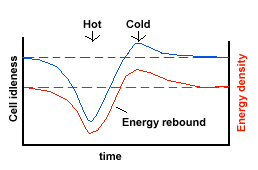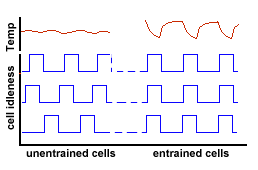
A bacterial infection in a human body adds a further population of cells to the complement of the body's own cells. These cells will almost certainly have a higher reproduction rate than the body's cells. Their high reproduction rate will usually mean that they are less idle than the body's slow-reproducing cells. What's likely to happen when a bacterial iinfection starts up?
Recurring Fever
Fast-reproducing bacteria are likely to generate rising bacteria populations in the intercellular medium. These rising populations, feeding off sugars and other fuels in the intercellular medium, will act to lower the energy density of that medium. As energy density falls, both bacterial cells and body cells will have to work harder to survive. Their idleness will fall. As their idleness falls, and they work harder, they will release more heat. As more heat is released, body temperature will rise, generating a fever.
 Bacterial populations will continue rising until bacterial idleness falls to zero, and bacteria start to die en masse. More idle body cells (more idle because they're not reproducing so rapidly) will survive.
Bacterial populations will continue rising until bacterial idleness falls to zero, and bacteria start to die en masse. More idle body cells (more idle because they're not reproducing so rapidly) will survive.
Although the mass death of the bacteria will occur at body temperature peaks, it won't be the high temperatures which kill off the bacteria. It will be the fact that bacterial cell idleness has fallen to zero.
The mass death of bacteria will produce a collapse in the bacterial cell population. At this point the energy density of the intercellular medium will cease to fall, and begin to gradually rise, depending upon how rapidly the body has managed to mobilise stored energy resources to meet the previous increased energy demand.
Body temperature will also peak at the same time. As the energy density of the intercellular medium returns to normal levels, cell idleness will rise, and heat output will fall, and body temperature will return to normal.
 If the body has mobilised large amounts of stored energy to release into the blood stream and the intercellular medium, the energy density of the medium may rise above normal levels (a 'rebound'). This will drop cell idleness still lower, reducing heat output even more, dropping body temperature below normal. The fever may be followed by chills. Chills are most likely where the bacterial population crash is sudden and precipitate, and comes just when the body is mobilising large amounts of stored energy. Where bacterial populations die off gradually, the 'rebound' effect will not be found.
If the body has mobilised large amounts of stored energy to release into the blood stream and the intercellular medium, the energy density of the medium may rise above normal levels (a 'rebound'). This will drop cell idleness still lower, reducing heat output even more, dropping body temperature below normal. The fever may be followed by chills. Chills are most likely where the bacterial population crash is sudden and precipitate, and comes just when the body is mobilising large amounts of stored energy. Where bacterial populations die off gradually, the 'rebound' effect will not be found.
Not all bacterial cells will die during the bacterial cell mass death. The survivors will likely be relatively slow-reproducing bacteria, with higher idleness than their peers. These slower-reproducing bacteria will then multiply to produce another bacterial population peak, and another mass death. At this new population peak, body cells will be working harder to survive than during prior peaks. So peak body temperatures will be higher during these subsequent population peaks, and the bouts of recurring fever will tend to get worse.

There's also another possible explanation for a fever-chill cycle. Cells are always flip-flopping between busy and idle states. In normal conditions, when one cell is just starting to get busy, some other cell will be returning to an idle state, so there'll be about as many cells all busy at the same time, and there'll be steady release of heat. But one of the effects of a collapse in internal environmental energy density may be that the cell busy-idle cycles may become entrained together, so that cells all work together, and all idle together. If cell cycle times are approximately equal, and are quite long (i.e. minutes of time), entrainment would bring a hot flush while cells were busy, followed by a cold flush when cells were idle. The ratio of hot-cold cycle times would be the same as the busy-idle cycle time ratio.
the cell busy-idle cycles may become entrained together, so that cells all work together, and all idle together. If cell cycle times are approximately equal, and are quite long (i.e. minutes of time), entrainment would bring a hot flush while cells were busy, followed by a cold flush when cells were idle. The ratio of hot-cold cycle times would be the same as the busy-idle cycle time ratio.
Eventually, after several recurring bouts of fever, either all the bacteria will die during a population crash, or a few very slow-reproducing bacterial cells will remain, whose populations will rise slowly or not at all, and will produce recurrence of symptoms at intervals of months or years.
In general, these sorts of bacterial infections won't kill the host in which they are multiplying. The most lethal infections will be those whose bacteria are more idle than body cells, so that at population peaks body cells begin to die before bacterial cells do. But for the most part, bacteria which have much the same physiology as host cells will generally be working harder to survive than host cells, if only because they're reproducing faster, and working harder in doing so.
Host cell death may however occur where host cells are already depleted of energy (perhaps because of some prior infection) when the bacterial infection commences. Depleted host cells may simply not have the internal energy resources with which to power increased work rates.
Equally, mass bacterial cell death may overload the ability of the body to purge dead bacterial cells from its blood stream - much like when a city's drains may overflow after a heavy thunderstorm.
In the above scenario, bacterial populations grow, and produce an energy density minimum and a temperature peak at the height of the fever, followed shortly afterwards by a energy density 'rebound' peak and accompanying falling temperature and chilling.
Orthodoxy
The above account of recurring fever, malarial or otherwise, is wholly unorthodox. The standard account of fever seems to be that the body resets its thermostat to a higher temperature during a bout of infection, and returns it to its normal levels later. Raising its temperature is regarded as part of the body's fight back against infection, with it being believed that the high temperatures kill off bacteria. The feeling of chill that accompanies a malarial infection is the consequence of the body resetting its thermostat to a higher level, making its actual temperature feel too low, and giving a sensation of chill, and helping to induce the host to do things like put on more clothes and turn up the heating, and so raise body temperature.
This account suggests that how warm or cold anyone feels is entirely subjective, and depends on the thermostat setting rather than the actual temperature of the body. Someone may feel either hot or cold at any body temperature. It also begs the question of why the body changes its thermostat setting. In response to what does it do this? Does the body say, "I'm under attack by a bacterial infection. Better turn up the temperature"?
In the Idle Theory model, however, people feel cold when they are losing body heat faster then they are internally generating it, and they feel hot when they are gaining body heat internally faster than they are losing it to the external environment. Thermal comfort is experienced when internal body heat generation approximately equals heat loss to the environment. When someone feels cold, putting on more clothes slows their rate of heat loss, and brings them back into balance. When they feel hot, taking off clothes restores balance by increasing heat loss. The body tries to avoid gaining or losing heat, and finds an equilibrium in between.
When someone is walking fast, or running, they are generating two or three times more internal heat than they are when standing still. But they will not feel uncomfortable if they are losing heat at the same rate as they are generating it, as airflow over their bodies increases with their forward speed. Their internal body temperatures probably rise slightly in the process. According to the thermostat model, this would mean they'd feel too hot. Does the body raise and lower the thermostat setting when someone is running or standing?
In Idle Theory's account of fever, the body isn't acting to 'fight off' infection. It doesn't know anything about any infection. It just carries on as normal. During the infection, the body's cells have to work harder to survive, and it is this that generates more heat, and raises body temperature. When the infection has passed, and equilibrium has been restored, the usual equilibrium body temperature is restored. There may not be anything remarkable about this temperature at all. With different organisms, there may well be different equilibrium body temperatures.
